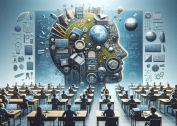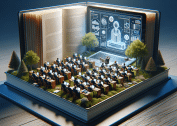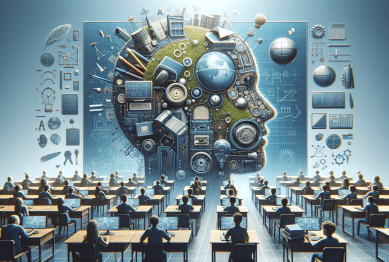Digital literacy unlocks more than just computer skills—it opens doors to critical thinking, communication, and lifelong learning. Explore what digital literacy means for students today, its impact on society, and the essential skills helping learners confidently navigate a connected world.
The Foundations of Digital Literacy in Modern Education
Digital literacy is much more than knowing how to use a computer. It involves the ability to find, evaluate, and create information using a range of digital technologies. For students in K–12 and higher education, digital literacy is essential for reaching academic success and preparing for a future work environment that’s shaped by technology. The rapid shift towards online learning environments has made these skills non-negotiable for learners and educators alike. As students engage with digital textbooks, virtual classrooms, and research platforms, their fluency in navigating these tools forms the backbone of modern education. Digital literacy doesn’t just help with learning new software. It teaches students how to safely and appropriately use the internet, critically assess online sources, and communicate ideas effectively on digital platforms. Mastering these competencies helps build the confidence needed to participate fully in the digital world, reducing the risk of falling behind as society’s reliance on technology deepens.
One foundational element of digital literacy is understanding how to locate and validate information online. The sheer volume of online content means students need to distinguish what’s credible, accurate, and useful from what’s misleading or false. Teaching these skills early helps learners avoid misinformation and develop strong research habits. This includes learning how to use search engines, databases, and digital libraries properly. As students increasingly engage in remote learning, their ability to assess the integrity of online material becomes even more vital. Educators play a key role by guiding students through effective questioning techniques and source evaluation, ensuring learners recognize persuasive language, bias, and the value of diverse perspectives. These critical thinking skills—paired with technical know-how—form a powerful combination that prepares students for success throughout their educational journey and beyond.
Technology also enables collaborative learning, empowering students to work together across distances. Digital platforms support group research projects, peer review, and real-time communication. These opportunities foster teamwork and global awareness. Understanding the etiquette of digital interactions—sometimes called netiquette—is a key piece of digital literacy. It teaches students to respect others, use appropriate language, and manage their digital footprints responsibly. These skills extend beyond the classroom, laying a foundation for future civic participation and career readiness. As society demands more digitally fluent citizens, promoting digital literacy in education becomes a shared priority for schools, parents, and policymakers alike. The goal is to equip every student with the skills needed to thrive in a world shaped by technology.
Critical Skills for Navigating Online Information
Today’s information landscape moves fast. Students encounter news, opinions, and multimedia from countless sources. To stay informed—and avoid pitfalls—digital literacy includes skills in online research, source validation, and fact-checking. Learners must know not only how to conduct online searches but also how to judge the reliability of what they find. Evaluating authorship, date of publication, and references helps distinguish factual content from opinion or advertising. Common pitfalls such as fake news, clickbait headlines, or viral misinformation challenge even seasoned internet users. Schools now integrate lessons on media literacy and online safety into their curriculums. These lessons teach students how to identify manipulative content and recognize bias. Building these skills strengthens student resilience to digital influence and supports informed decision-making both inside and outside the classroom.
Fact-checking is a crucial aspect of digital literacy. When faced with controversial or breaking news, students are encouraged to examine multiple reputable sources before sharing information. This disciplined approach reduces the spread of unverified claims and maintains a trustworthy online environment. Critical thinking intersects with digital skills at every step—whether comparing health data on government websites or verifying statistics for a school assignment. Teachers play an important role by modeling effective research behaviors and encouraging skepticism towards sensationalized or unreferenced posts. Toolkits from respected educational and media organizations can guide both students and educators, introducing structured routines for online research and responsible information sharing. As artificial intelligence and deepfakes increase in sophistication, these skills become even more vital for discerning truth from fiction.
Collaboration across disciplines amplifies the power of digital literacy. Social studies, science, language arts, and technical education classes all require students to interact with online materials in context-specific ways. Integrating digital literacy across subjects reinforces its value and relevance. Educators use project-based learning, group presentations, and peer review platforms to cultivate research and analysis skills. By embedding digital literacy into diverse academic experiences, schools ensure students develop well-rounded, transferable competencies. Families can support this at home by encouraging open discussions about media consumption habits, news sources, and online privacy. Over time, repeated exposure and guided practice foster independent, critical thinkers prepared to handle the evolving challenges of the information age.
Online Communication and Collaboration Essentials
Communication has changed. Students now write emails, post on discussion forums, and present findings through interactive media. Digital literacy empowers learners to use these tools skillfully and respectfully. Crafting clear emails, respecting privacy settings, and choosing the right communication channel all form part of this skillset. As group work moves online, knowing how to participate constructively in team chats or video calls is more important than ever. Students must also understand digital etiquette, ensuring that their tone, language, and emoji use are appropriate for each context. Practicing these skills not only prevents misunderstandings but also helps foster positive classroom and community relationships across cultures and age groups.
Digital collaboration tools abound. From shared documents to virtual brainstorming platforms, students can work together in real time—no matter where they are. These experiences teach learners to delegate tasks, set deadlines, and provide constructive feedback. They also require adaptability and empathy as students encounter diverse working styles and perspectives. Teachers may assign group projects using online platforms that record contributions, making it easier to track participation and address any issues early on. Group presentation skills and peer review processes can help students practice clear communication, professional conduct, and problem-solving in a digital setting. These competencies have benefits reaching far beyond the classroom—they apply to remote work, higher education, and community engagement in the modern world.
Digital citizenship is another cornerstone of online communication literacy. This concept expands traditional etiquette to include the ethical and legal responsibilities of internet use. Students learn about cyberbullying, copyright respect, and how to maintain a positive digital footprint. Responsible social media use and understanding the permanence of online posts are essential life skills. Educators rely on resources from government agencies and nonprofits to support safe online behaviors and prevent misuse. By making digital citizenship a visible part of classroom culture, schools contribute to safer, more supportive learning environments—reducing risk to students while empowering them to navigate the web confidently.
Bridging the Digital Divide for Equity in Education
Access to technology is not universal. The digital divide refers to gaps in access to devices, high-speed internet, and digital literacy training—especially among students in under-resourced communities. This divide can limit opportunities for learning, personal growth, and future employment. Schools and community organizations work constantly to close these gaps by providing devices, expanding Wi-Fi access, and offering targeted digital skills training programs. Public libraries and nonprofit organizations also play a vital role, hosting computer labs and workshops open to learners of all ages. Equitable access to technology is essential if all students are to enjoy the benefits of digital education.
Teachers adapt to these challenges by designing lessons that can be completed with or without a device, or by lending hardware to families in need. Some schools introduce low-tech alternatives when internet service is unreliable. Policy initiatives at the local, state, and national levels support efforts to close the digital divide through funding and expanded infrastructure. For example, broadband expansion programs, subsidized tablet initiatives, and teacher training in digital literacy help ensure all learners have a fair shot at digital success. Community partnerships between schools, technology companies, and local governments often provide the hardware, software, and know-how to bridge these persistent gaps.
When digital equity improves, entire communities benefit. Students can participate fully in online classes, complete homework, and apply for scholarships or jobs. Access to online government resources, health information, and civic engagement platforms also grows. Closing the digital divide doesn’t just impact individual achievement; it helps raise the quality of life for families and support the economic growth of neighborhoods. Long-term solutions must address not just device access but also ongoing training, digital safety, and opportunities for meaningful engagement with technology. Policymakers, educators, and families will need to work together, championing digital inclusion as a path to educational and social equity.
Preparing for the Future: Digital Literacy and Lifelong Learning
The skills students gain through digital literacy education extend well beyond school. The modern workplace values creativity, problem-solving, and adaptability—traits nurtured by a strong foundation in digital skills. Many roles require using spreadsheets, cloud platforms, or video conferencing as part of daily work. Employers often seek candidates who can quickly learn new tools and communicate effectively in virtual teams. Digital literacy also supports entrepreneurship, freelance work, and self-directed learning in a fast-changing economic landscape. As technology continues to evolve, the most successful individuals will be those comfortable learning, unlearning, and adapting in a digital setting.
Lifelong learning is closely linked to digital literacy. Online courses, webinars, and open educational resources allow individuals to grow their knowledge and skills at every life stage. Whether it’s upskilling for a new job, staying informed about current events, or exploring personal interests, digital tools offer limitless possibilities for education and self-improvement. Libraries, universities, and organizations offer free or low-cost virtual learning opportunities, making personal and professional growth more attainable for everyone. Digital literacy gives learners the independence to pursue these opportunities confidently and safely, navigating both open access and secure platforms with ease.
Ultimately, digital literacy prepares individuals to participate fully in civic life. This includes engaging with e-government services, accessing telehealth, contributing to online communities, and voting or voicing opinions safely online. As society’s digital landscape grows more complex, the ability to understand, adapt, and make informed choices through technology is invaluable. Schools lay the groundwork, but continuous collaboration between educators, families, and communities helps create a culture of lifelong learning. Cultivating digital literacy today ensures a more equitable, engaged, and innovative society for the future.
References
1. U.S. Department of Education. (n.d.). Reimagining the role of technology in education. Retrieved from https://tech.ed.gov/files/2017/01/NETP17.pdf
2. American Library Association. (n.d.). Digital literacy. Retrieved from https://literacy.ala.org/digital-literacy/
3. Common Sense Media. (n.d.). Teaching digital citizenship. Retrieved from https://www.commonsense.org/education/digital-citizenship
4. National Center for Education Statistics. (n.d.). The digital divide and digital equity. Retrieved from https://nces.ed.gov/programs/coe/indicator/cxe/digital-divide
5. Pew Research Center. (n.d.). Digital readiness gaps. Retrieved from https://www.pewresearch.org/internet/2016/09/20/digital-readiness-gaps/
6. International Society for Technology in Education. (n.d.). ISTE standards for students. Retrieved from https://www.iste.org/standards/iste-standards-for-students









